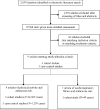Physical activity, cardiorespiratory fitness and risk of cutaneous malignant melanoma: Systematic review and meta-analysis
- PMID: 30379884
- PMCID: PMC6209223
- DOI: 10.1371/journal.pone.0206087
Physical activity, cardiorespiratory fitness and risk of cutaneous malignant melanoma: Systematic review and meta-analysis
Abstract
Background: Numerous epidemiologic studies have examined the relation of physical activity or cardiorespiratory fitness to risk of cutaneous melanoma but the available evidence has not yet been quantified in a systematic review and meta-analysis.
Methods: Following the preferred reporting items for systematic reviews and meta-analyses (PRISMA), we identified 3 cohort studies (N = 12,605 cases) and 5 case-control studies (N = 1,295 cases) of physical activity and melanoma incidence, and one cohort study (N = 49 cases) of cardiorespiratory fitness and melanoma risk.
Results: Cohort studies revealed a statistically significant positive association between high versus low physical activity and melanoma risk (RR = 1.27, 95% CI = 1.16-1.40). In contrast, case-control studies yielded a statistically non-significant inverse risk estimate for physical activity and melanoma (RR = 0.85, 95% CI = 0.63-1.14; P-difference = 0.02). The only available cohort study of cardiorespiratory fitness and melanoma risk reported a positive but statistically not significant association between the two (RR = 2.19, 95% CI = 0.99-4.96). Potential confounding by ultraviolet (UV) radiation-related risk factors was a major concern in cohort but not case-control studies.
Conclusions: It appears plausible that the positive relation of physical activity and cardiorespiratory fitness to melanoma observed in cohort studies is due to residual confounding by UV radiation-related risk factors.
Impact: Future prospective studies need to examine the association between physical activity, cardiorespiratory fitness and melanoma after detailed adjustment for UV radiation-related skin damage.
Conflict of interest statement
The authors have declared that no competing interests exist.
Figures



Similar articles
-
Association Between Physical Activity, Sedentary Behavior and Physical Fitness and Glycated Hemoglobin in Youth with Type 1 Diabetes: A Systematic Review and Meta-analysis.Sports Med. 2023 Jan;53(1):111-123. doi: 10.1007/s40279-022-01741-9. Epub 2022 Aug 3. Sports Med. 2023. PMID: 35922715
-
Cardiorespiratory fitness, muscular strength and risk of type 2 diabetes: a systematic review and meta-analysis.Diabetologia. 2019 Jul;62(7):1129-1142. doi: 10.1007/s00125-019-4867-4. Epub 2019 Apr 23. Diabetologia. 2019. PMID: 31011778 Free PMC article.
-
Prevention of Long-term Adverse Health Outcomes With Cardiorespiratory Fitness and Physical Activity in Childhood Acute Lymphoblastic Leukemia Survivors.J Pediatr Hematol Oncol. 2019 Oct;41(7):e450-e458. doi: 10.1097/MPH.0000000000001426. J Pediatr Hematol Oncol. 2019. PMID: 30688830
-
Associations of Sedentary Behavior, Physical Activity, Cardiorespiratory Fitness, and Body Fat Content With Pain Conditions in Children: The Physical Activity and Nutrition in Children Study.J Pain. 2016 Jul;17(7):845-53. doi: 10.1016/j.jpain.2016.03.011. Epub 2016 Apr 25. J Pain. 2016. PMID: 27126997
-
A systematic review of physical activity and cardiorespiratory fitness on P3b.Psychophysiology. 2020 Jul;57(7):e13425. doi: 10.1111/psyp.13425. Epub 2019 Jun 22. Psychophysiology. 2020. PMID: 31228362
Cited by
-
Impact of Physical Exercise on Melanoma Hallmarks: Current Status of Preclinical and Clinical Research.J Cancer. 2024 Jan 1;15(1):1-19. doi: 10.7150/jca.88559. eCollection 2024. J Cancer. 2024. PMID: 38164270 Free PMC article. Review.
-
Life-Course Trajectories of Physical Activity and Melanoma Risk in a Large Cohort of Norwegian Women.Clin Epidemiol. 2022 Dec 22;14:1571-1584. doi: 10.2147/CLEP.S382454. eCollection 2022. Clin Epidemiol. 2022. PMID: 36578536 Free PMC article.
-
Dual Encapsulated Dacarbazine and Zinc Phthalocyanine Polymeric Nanoparticle for Photodynamic Therapy of Melanoma.Pharm Res. 2021 Feb;38(2):335-346. doi: 10.1007/s11095-021-02999-w. Epub 2021 Feb 18. Pharm Res. 2021. PMID: 33604784
-
Adolescent cardiorespiratory fitness and risk of cancer in late adulthood: A nationwide sibling-controlled cohort study in Sweden.PLoS Med. 2025 May 8;22(5):e1004597. doi: 10.1371/journal.pmed.1004597. eCollection 2025 May. PLoS Med. 2025. PMID: 40338834 Free PMC article.
-
A genetically informed study reveals modifiable pathways in skin cancer.J Transl Med. 2024 Oct 8;22(1):916. doi: 10.1186/s12967-024-05719-1. J Transl Med. 2024. PMID: 39379979 Free PMC article.
References
-
- Erdmann F, Lortet-Tieulent J, Schuz J, Zeeb H, Greinert R, Breitbart EW, et al. International trends in the incidence of malignant melanoma 1953-2008—are recent generations at higher or lower risk? International journal of cancer Journal international du cancer. 2013;132(2):385–400. 10.1002/ijc.27616 . - DOI - PubMed
-
- Geller AC, Clapp RW, Sober AJ, Gonsalves L, Mueller L, Christiansen CL, et al. Melanoma epidemic: an analysis of six decades of data from the Connecticut Tumor Registry. Journal of clinical oncology: official journal of the American Society of Clinical Oncology. 2013;31(33):4172–8. 10.1200/JCO.2012.47.3728 ; PubMed Central PMCID: PMC3906570. - DOI - PMC - PubMed
-
- Kojo K, Jansen CT, Nybom P, Huurto L, Laihia J, Ilus T, et al. Population exposure to ultraviolet radiation in Finland 1920–1995: Exposure trends and a time-series analysis of exposure and cutaneous melanoma incidence. Environmental research. 2006;101(1):123–31. 10.1016/j.envres.2005.09.007 . - DOI - PubMed

